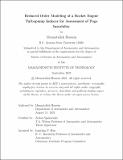Reduced Order Modeling of a Rocket Engine Turbopump Inducer for Assessment of Pogo Instability
Author(s)
Hussein, Mennatallah
DownloadThesis PDF (6.330Mb)
Advisor
Spakovszky, Zoltán
Terms of use
Metadata
Show full item recordAbstract
Cavitation in liquid rocket engine turbopump inducers can lead to system instabilities. One form of these flow oscillations is so-called "pogo instability", in which dynamic instability arises from the interaction of vehicle structural dynamics with thrust oscillations of a liquid fueled propulsion system. These thrust oscillations are a result of the pressure fluctuations that originate in the piping system, the injector, the combustion chamber, and/or the turbopump inducers when cavitating. The main challenges associated with pogo analyses are the complexity of fluid-structure coupling, a disparity in findings about mechanisms for cavitation onset, sparse amount of data on inducer dynamic behavior. This research presents a modular approach for dynamical system modeling capturing structural dynamics due to viscous shear to study their effect on a cavitating dynamics and overall pogo instabilities. An existing cavitating inducer model is extended to include the effect of viscous shear on the piping structure, and is then integrated in a simple rocket engine feedline model to characterize pogo instability with a direct link to changes in operating conditions and design choices. The open loop system analysis captures the effect of viscous shear on cavitation surge. This dissipating mechanism adds damping and stabilizes the system. The closed loop system analysis demonstrates that the reduced order model is capable of assessing the effect of viscous shear induced structural vibrations on overall system stability. Based on these ideas, this work sets the stage for pogo analysis of more complicated configurations.
Date issued
2023-09Department
Massachusetts Institute of Technology. Department of Aeronautics and AstronauticsPublisher
Massachusetts Institute of Technology